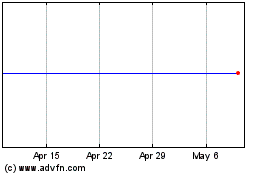Wireless War Erupts Over 'Internet of Things'
December 09 2015 - 7:07PM
Dow Jones News
By Don Clark
Cellular and Wi-Fi networks are good for connecting smartphones,
tablets and laptops. But different technology may be needed when
things such as parking meters and vending machines need to
communicate.
That is the thesis driving a crop of companies promoting a new
breed of wireless networks. Silver Spring Networks Inc., a Silicon
Valley company best known for developing systems that let utility
meters transmit data on energy usage, is the latest to unveil a
plan to connect a variety of industrial and consumer machines
collectively known as the Internet of Things, or IoT.
Mike Bell, a former executive of Intel Corp. and Apple Inc. who
recently became the company's chief executive, on Wednesday
announced plans to reach a broader audience with an international
wireless network called Starfish. Mr. Bell debuted the technology
in San Jose, Calif., where Silver Spring intends to establish one
of its first Starfish installations to let everyday objects share
data about their activities and surroundings.
Silver Spring's announcement--which caused its shares to jump 6%
on Wednesday--followed a collaboration announced in October between
the city of San Francisco and SigFox, a French company with its own
IoT network technology.
Plans for other new IoT networks have been discussed by vendors
such as Ingenu, a San Diego-based startup, and a group of companies
backing a technology dubbed LoRa that was developed by Semtech
Corp., a chip maker in Calabasas, Calif.
These efforts share some common assumptions. One is that
short-range wireless standards such as Wi-Fi and Bluetooth won't
work for many IoT applications, such as connecting tractors to
sensors used by farmers or industrial equipment arrayed across
broad geographic areas.
Another assumption is that long-range cellular networks are too
costly and draw too much power to do the job. Where smartphones
that send videos and data files need high-speed networks, many IoT
devices may send just a few small packets of data several times a
day. Backers of the new IoT networks quote battery life of 10 years
or more for connected devices.
A lot of money could be at stake. Market researcher Jim Morrish,
founder of Machina Research, thinks the total market for the new
wireless networks could total $20 billion by 2020.
Cellular carriers have been working on lower-powered variants
for IoT applications, and the new entrants are spurring them to
move faster.
"It has caused the operators to wake up," said Dan Shey, an
analyst at ABI Research.
Stephen DiFranco, a senior vice president at communications chip
maker Broadcom Corp., predicted that the incumbent cellular
networks eventually would dominate IoT applications. As for the new
entrants, "we don't agree with the path they are going down," he
said.
Mr. Bell, who led Intel's efforts in putting chips in devices
such as smartwatches and fitness trackers, thinks Silver Spring has
a head start in the field, having helped set up utility networks
that connect 22 million devices.
He also touts what he regards as a technological advantage. Most
wireless networks operate in what is sometimes called a
hub-and-spoke arrangement; remote devices communicate with
individual base stations that are connected to the Internet. Silver
Spring, by contrast, operates a mesh network that passes signals
along a grid of antennas. The company says the approach makes its
potential range nearly limitless, while two individual devices can
send data up to 50 miles.
Silver Spring uses technology specified by an industry
standard-setting group. Mr. Bell said standardization will allow
companies other than Silver Spring to make Starfish-compatible
transmitters.
"We will be just as happy when other devices are available," he
said.
SigFox developed proprietary technology but has licensed it to
multiple chip makers, said Allen Proithis, president of that
company's North American unit. The LoRa alliance claims 175 member
companies and plans for 12 IoT networks, said Hardy Schmidbauer,
Semtech's director of wireless products.
Ingenu, originally called On-Ramp Wireless, has raised more than
$100 million in funding. The company's proprietary technology has
advantages such as battery life of up to 20 years for IoT devices
using its network, said Chief Executive John Horn.
Some rivals think the slow speed of the new networks poses a
serious problem. One is Sensity Systems, a Silicon Valley company
promoting IoT networks based on Wi-Fi connections. "You need
video--and you can't run video on low bandwidth networks," said
Chief Operating Officer Sean Harrington.
Write to Don Clark at don.clark@wsj.com
(END) Dow Jones Newswires
December 09, 2015 18:52 ET (23:52 GMT)
Copyright (c) 2015 Dow Jones & Company, Inc.
SILVER SPRING NETWORKS INC (NYSE:SSNI)
Historical Stock Chart
From Aug 2024 to Sep 2024

SILVER SPRING NETWORKS INC (NYSE:SSNI)
Historical Stock Chart
From Sep 2023 to Sep 2024
